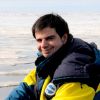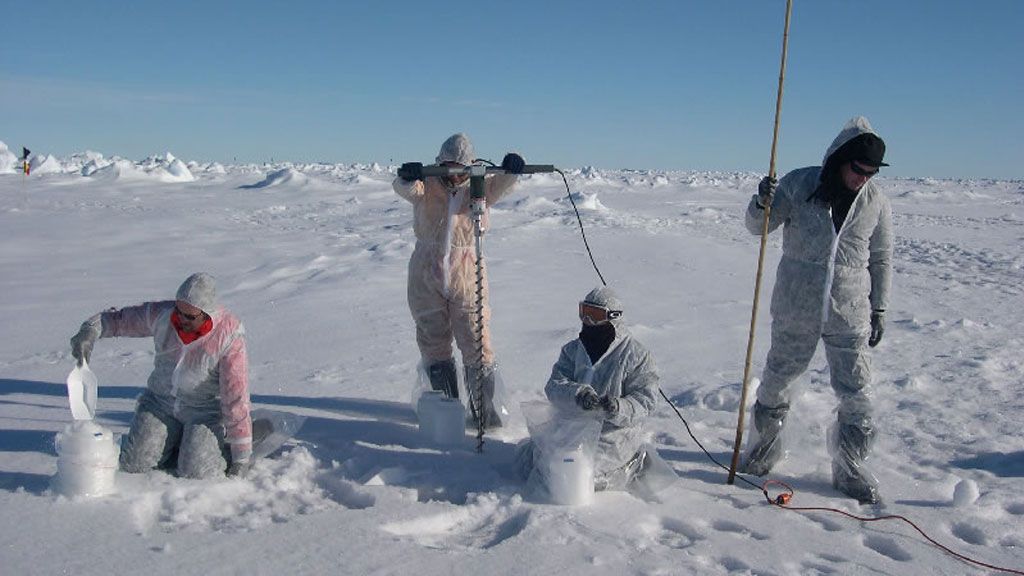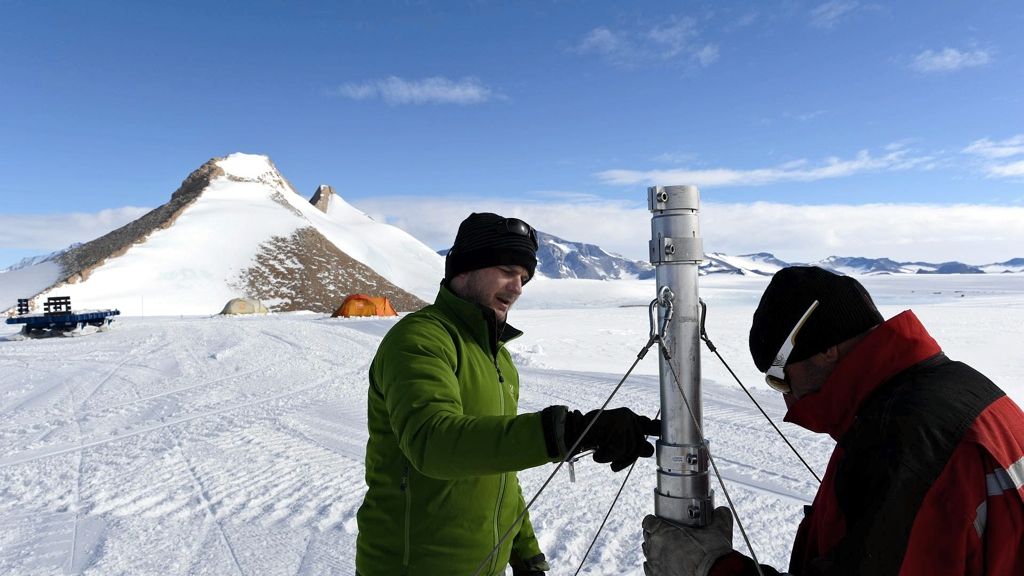A closer look at carbon cycling in Antarctica
Sampling Antarctic pack ice in trace metal clean conditions
© BRUNO DELILLE
Dr. Bruno Delille is a sea ice researcher and oceanographer from the University of Liège in Belgium. He has been involved in past research projects such as BELCANTO (BELgian research on Carbon uptake in the ANTarctic Ocean), which was studying carbon cycling (how carbon is cycled between atmosphere, marine life forms and deep ocean waters).
He is currently involved in the follow-up research project, BIGSOUTH (BIoGeochemical cycles in the SOUTHern ocean), which has been looking at fluxes of greenhouse gasses between the ocean, sea ice and the atmosphere as well as biogeochemical processes (processes that involve substances organisms such as phytoplankton and other primary producers at the bottom of the food chain produce) taking place in sea ice covered areas in the Southern Ocean.
In this interview, Dr. Delille discusses each of these research projects.
You were involved in the BELCANTO project, which recently ended. Could you tell us about that project?
The BELCANTO project was designed to investigate carbon cycling in the Southern Ocean between the atmosphere and the various layers of the ocean, particularly in light of climate change.
The Southern Ocean is a strong sink for atmospheric carbon dioxide (CO2). It is also believed to have played a significant role in the transition between the Earth’s glacial and interglacial periods, which is why the changes the Southern Ocean is currently undergoing as a consequence of climate change are of particular interest. BELCANTO and its follow-up research project, BIGSOUTH, aim to give us a better understanding of the processes.
Another purpose of the BELCANTO project was to design models to reproduce carbon uptake in the Southern Ocean incorporating the processes related to carbon uptake. Right now we’re trying to get this model running accurately. But at the moment it’s not clear whether primary producers at the bottom of the food chain in the Southern Ocean such as phytoplankton will increase or decrease as the climate changes. It’s quite a complex process.
What do we currently know about carbon mass balance between the ocean and atmosphere, how it’s transported, and how it’s being affected by climate change?
Human activity is estimated to release 7 Gigatons (that’s 7,000,000,000,000 kilograms) of carbon into the Earth’s atmosphere every year. Of this 7 Gigatons, one third is absorbed by the world’s oceans, another third is absorbed by plants in the terrestrial biosphere, and the final third remains in the atmosphere and contributes to climate warming. So the oceans are playing a tremendous role in absorbing the excess CO2 human activity produces.
Climate change is currently affecting the oceans. In the coming years decreasing sea ice extent will be an important climate forcing mechanism, especially in the Arctic where sea ice loss is more pronounced.
Other phenomena we’re currently seeing include increasing temperatures, as well as changes in weather, wind patterns, and ocean currents. And of course ocean acidification will be an issue, especially in the Arctic and Antarctic.
Why will ocean acidification be more pronounced in the Polar Regions?
It is not the ocean acidification per se that is the most alarming, but rather the concurrent decrease in the saturation level of calcium carbonate (CaCO3) in seawater. Many factors determine the saturation level of calcium carbonate: not only pH, but also the temperature and salinity of the seawater at a given location. In cold waters, the saturation level of calcium carbonate is lower. If this saturation level drops below a threshold value of 1, calciferous organisms will face detrimental thermodynamical conditions that will affect their ability to precipitate calcium carbonate from the ocean water to form their shells and exoskeletons.
Due to their lower temperatures, the polar oceans will pass this threshold earlier than oceans in more temperate parts of the planet. A 2008 paper published by Ben I. McNeil of the University of New South Wales and Richard J. Matear of the Centre for Australian Weather and Climate Research found that this threshold could be passed in the next 30 years.
Is there a specific pH below which calciferous organisms will be seriously impacted?
Again, it’s more the saturation level of calcium carbonate that’s important. However this does depend on pH to some extent, and it wouldn’t take much of a drop in order to reach this saturation point. Right now the oceans are at a pH of about 8.1. In order for this important threshold to be passed, the pH would probably need to drop to 7.7 or something like this – a pH level that is still slightly alkaline, but low enough to make it difficult for calciferous organisms to form their shells and exoskeletons.
Is there a limit to the amount of CO2 the oceans can absorb?
In terms of CO2 concentrations, the surface of the ocean is in equilibrium with the atmosphere, meaning both have the same concentration of CO2. If the concentration of CO2 in the atmosphere increases, then the concentration of CO2 of the surface ocean will increase to remain at the same level as the atmosphere. This increase of oceanic CO2 means that the surface water is taking up CO2 from the atmosphere and the increase of atmospheric CO2 is mitigated. However, the more we inject CO2 into the atmosphere, the less the oceans will absorb CO2 to maintain the equilibrium. As a result, the oceanic uptake of CO2 will steadily decrease.
Surface waters in the ocean eventually descend to the bottom of the ocean at places of deep water formation – where the lower temperatures and higher salinity of ocean water cause surface water to sink (in the north Atlantic and round Antarctica). This helps drive the planet’s Thermohaline Circulation (THC) – the network of global ocean currents. It takes centuries for water to make a complete circuit around the planet via the THC, along with the CO2 brought down from the surface. As a result and as long as the concentration of CO2 in the atmosphere is rising, the ocean will absorb and sequester significant part of excess atmospheric CO2.
Will this deep water eventually return to the surface at areas of the oceans where deepwater upwells?
Yes. However the deep water is at the atmospheric CO2 concentration when it left the surface, meaning at the atmospheric concentration of several centuries before. If CO2 levels continue to increase, this water could be undersaturated with CO2 compared to future atmospheric concentrations of CO2. As a result, this water will absorb more CO2 to reach the new atmospheric CO2 concentration and will eventually sink and start the cycle again.
But this is a cycle that takes hundreds of years to complete, which means CO2 we emit into the atmosphere today will still be dissolved in ocean water centuries from now.
How can carbon be stored permanently at the bottom of the ocean?
The quickest way is through primary producers like phytoplankton and diatoms. They incorporate carbon into their bodies during their lifetime, and then either they sink to the bottom of the ocean after they die, or other animals that eat them and incorporate this carbon into their bodies. Animals higher up the food chain return the carbon to the sea floor either through excreting fecal matter or in their bodies after they die. This is a much faster process than ocean mixing.
What research are you currently involved with?
BELCANTO recently finished, but most of the scientists who worked on the program are continuing research along the same lines under a project called BIGSOUTH. This project will continue to investigate carbon cycling, but with greater emphasis on the role of sea ice. We’re studying climate gas fluxes between the sea ice and the atmosphere as well as between sea ice and the ocean. We’re also looking at biogeochemistry in the Southern Ocean and iron cycling. And we’re also doing some modelling. This is the main project I’m working on at the moment.
I’m particularly interested in investigating sea ice and how it plays a role not only in influencing primary producers, which live in the sea ice, but also the role sea ice plays in climate gas exchange. It’s only in the last seven years that scientists have started looking at gas transfer between sea ice and the atmosphere. Prior to seven years ago, sea ice was erroneously considered an inert barrier for gas exchange between the ocean and the atmosphere.
With the participation of Dr Jean-Louis Tison, a glaciologist from the French-speaking Free University of Brussels (ULB), we started carrying out measurements of CO2 fluxes between the sea ice and the atmosphere during the 2003-2004 Antarctic season. And then we observed gas transfer across sea ice interface and started to focus on climate gas dynamics in sea ice and related air-sea ice exchanges.
We also started looking at fluxes of other greenhouse gases like methane (CH4) and nitrous oxide (N2O) between the sea ice and the atmosphere. In addition to this, we’re looking at fluxes of other climate gases that are not greenhouse gases, but play an opposite role in promoting climate cooling. We’re focusing on dimethyl sulfide ((CH3)2S), which is a byproduct of phytoplankton and microalgae metabolism. These sulfur compounds are released into the atmosphere and can act as condensation nuclei for water droplets in the atmosphere, which essentially means they promote cloud formation. And by promoting cloud formation these sulfur compounds decrease the radiative balance of the Earth, increasing its albedo. This a hot research topic right now.
On top of this, we’re studying primary production in the sea ice and iron cycling - how iron is cycled between landforms, the atmosphere, the oceans and lifeforms. The Southern Ocean is a high-nutrient and low-chlorophyll area. This means that there is an excess of nutrients that primary producers at the bottom of the food chain like phytoplankton need to grow – so more nutrients available than there are phytoplankton to consume them. However there is a lack of one important micronutrient: iron. This is important because there are theories about the transition between glacial and interglacial periods that involve changes in the iron supply in the Southern Ocean and primary production in the Southern Ocean. There are a number of hypotheses about how the ocean can play a role in these glacial-interglacial transitions.
So if we have more iron available in the Southern Ocean, it means there can be more primary production and thus more CO2 uptake. There are geoengineering projects that have proposed adding iron in the Southern Ocean to foster primary production. This helps absorb carbon dioxide from the atmosphere as the primary producers incorporate the carbon into their bodies and transport it to the bottom of the ocean when they die. It has been hypothesized that this can decrease the impact of anthropogenic greenhouse gasses into the atmosphere.
Haven’t these kinds of geoengineering projects proven less successful than anticipated?
There have been several iron fertilization experiments, and in fact they have demonstrated that seeding the Southern Ocean with iron to promote primary production won’t work. It turns out that it’s not a very efficient way to increase carbon uptake from the atmosphere. Yet there are still some groups who are saying that these geoengineering solutions are a way to counteract the negative effects of anthropogenic greenhouse gas emissions, but won’t work in the end. I only mentioned these projects just to illustrate the importance of iron in primary production.
Are there any specific research activities you plan to undertake during the upcoming season in Antarctica?
During the 2011-2012 season, about six other Belgian researchers and I plan to go to New Zealand’s Scott Base on Ross Island, not far from the American McMurdo Station. Starting in November, we intend to conduct a survey of climate gas fluxes between sea ice and the atmosphere along with sea ice biogeochemistry in this region. We’ll set up instruments on the ice to be able to record gas fluxes as the sea ice retreats during the austral spring and summer and then advances during the austral autumn and winter. We plan to leave these instruments on the ice throughout the austral winter and collect readings of gas fluxes. When the ice is solid enough to walk on it at the end of the austral winter in August 2012, two people from our team will go on the ice and take ice samples. And then after a personnel rotation, I plan to return in November 2012 to finish the sampling and collect data from the previous year.
It’s an important study because a year-long survey of sea ice gas fluxes and ice biogeochemistry has never been done before. Taking samples on the sea ice in the middle of the austral winter will also be a unique opportunity.
For how many years will the BIGSOUTH research project continue?
It’s a four-year project funded by the Belgian Federal Policy Office (BELSPO). The network has been relatively active since 1996. We hope to remain active for quite a long time. There’s still a lot to learn about these gas flux processes.

Bruno Delille
Bruno Delille is a sea ice researcher and oceanographer from the University of Liège whose research interests include Inorganic carbon dynamics in the polar oceans (open ocean, subantarctic coastal area, sea ice specific processes), sea ice biogeochemistry, inorganic carbon dynamics in the coastal ocean, impact of ocean acidification on inorganic and organic carbon production of phytoplancton communities.





